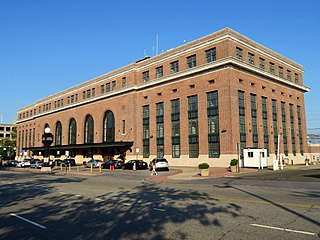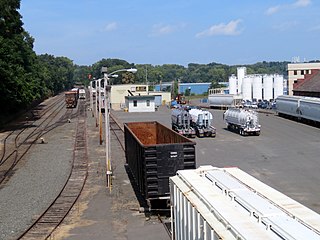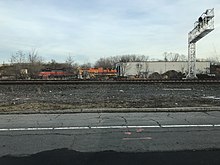
The New York, New Haven and Hartford Railroad, commonly known as The Consolidated, or simply as the New Haven, was a railroad that operated in the New England region of the United States from 1872 to December 31, 1968. Founded by the merger of the New York and New Haven and Hartford and New Haven railroads, the company had near-total dominance of railroad traffic in Southern New England for the first half of the 20th century.

Union Station, also known as New Haven Railroad Station or simply New Haven, is the main railroad passenger station in New Haven, Connecticut. It is the third such station in the city of New Haven, preceded by both an 1848 built station in a different location, and an 1879 built station near the current station's location. Designed by noted American architect Cass Gilbert, the present beaux-arts Union Station was completed and opened in 1920 after the previous Union Station was destroyed by fire. It served the New York, New Haven and Hartford Railroad for the next five decades, but fell into decline following World War II along with the United States railroad industry as a whole.

The Providence and Worcester Railroad is a Class II railroad operating in Rhode Island, Massachusetts, and Connecticut, as well as New York via trackage rights. The company was founded in 1844 to build a railroad between Providence, Rhode Island and Worcester, Massachusetts, and ran its first trains in 1847. A fast success, the P&W subsequently expanded with a branch to East Providence, Rhode Island, and for a time leased two small Massachusetts railroads. Its busy mainline was double-tracked beginning in 1853, following a fatal collision that year in Valley Falls, Rhode Island.

The Danbury Branch is a diesel branch of the Metro-North Railroad New Haven Line from downtown Norwalk, Connecticut north to Danbury, mostly single-tracked. It opened in 1852 as the Danbury and Norwalk Railroad. Until the early 1970s, passenger service continued north from Danbury to Canaan, Connecticut and Pittsfield, Massachusetts. Metro-North took over operation of the line from Conrail in 1983.

Founded in 1996, the Naugatuck Railroad is a common carrier railroad owned by the Railroad Museum of New England and operated by Naugatuck Railroad on tracks leased by Naugatuck Railroad from the Connecticut Department of Transportation. The original Naugatuck Railroad was a railroad chartered to operate through south central Connecticut in 1845, with the first section opening for service in 1849. In 1887 the line was leased by the New York, New Haven and Hartford Railroad, and became wholly owned by 1906. At its greatest extent the Naugatuck ran from Bridgeport north to Winsted. Today's Naugatuck Railroad runs from Waterbury to the end of track in Torrington, Connecticut. From Waterbury south to the New Haven Line, Metro-North Railroad operates commuter service on the Waterbury Branch.

The Harlem River and Port Chester Railroad (HR&PC) was chartered in 1866 as a branch line railroad between New York City and Port Chester, New York. The line opened in 1873 as part of the New York, New Haven and Hartford Railroad and served in various capacities until 1971. The HR&PC is now part of the Hell Gate Line section of Amtrak's high-speed Northeast Corridor.

The Connecticut Southern Railroad is a 90-mile (140 km) long short-line railroad operating in Connecticut and Massachusetts. The company was formed in 1996 as a spinoff of Conrail by shortline holding company RailTex and subsequently acquired in 2000 by RailAmerica. Since 2012, it has been a subsidiary of Genesee & Wyoming. CSO is headquartered in Hartford, Connecticut, site of its Hartford Yard. The company also operates East Hartford Yard.

Ted's Restaurant is a hamburger restaurant established in 1959 that is known for its steamed cheeseburger. Its original location is in Meriden, Connecticut, in the United States. It also operates a food truck and a concession stand.

The Pioneer Valley Railroad, founded in 1982, is a Class III short line freight railroad operating the former Conrail trackage in the western part of Massachusetts in towns of Westfield, Holyoke, and Southampton. The railroad has been owned by the Pinsly Railroad Company since its founding, with headquarters in Westfield, Massachusetts.

The Connecticut Valley Railroad was a railroad in the state of Connecticut founded in 1868. The company built a line along the Connecticut River between Hartford and Old Saybrook, which opened in 1871. It was reorganized as the Hartford and Connecticut Valley Railroad in 1880, and leased by the New York, New Haven and Hartford Railroad in 1887. Following partial abandonments by the New Haven Railroad and successor Penn Central Transportation Company between 1968 and 1972, the line south of Middletown was revived as the Valley Railroad, a heritage railroad, while the portion in Middletown and northward saw operation by several freight railroads. As of 2022, the Providence and Worcester Railroad and Connecticut Southern Railroad both operate portions of the former Connecticut Valley Railroad.

The Hartford Yard Goats are a Minor League Baseball team based in Hartford, Connecticut. The Yard Goats, which play in the Eastern League, are the Double-A affiliate of the Colorado Rockies. The team was founded in 2016 when the New Britain Rock Cats relocated to Hartford. The Yard Goats' home stadium is Dunkin' Donuts Park.
Laura "Polly" Lada-Mocarski, born as Laura Mitchell Klots (1902–1997) was an American craftsperson, rare book scholar, bookbinder, book preservationist, educator, and the inventor of the PolyCase, an exhibition display for old and rare books. She served as faculty in the Graphic Arts Department at Yale University.

Horatio Theodore Strother was an American historian and educator who wrote an influential 1962 book on the Underground Railroad in Connecticut. His teaching career culminated in a professorship at the University of New Haven from the 1960s.

Gardner Dow was an American college football player for the Connecticut Aggies. He died of traumatic brain injury sustained in a game against the University of New Hampshire. Connecticut Agricultural College named its athletic field in his honor. The Gardner Dow Field served as the football team's home pitch for decades.
Francisco Lopes Borges is an American politician and business executive who served as Connecticut State Treasurer from 1987 to 1993, succeeding Joan R. Kemler. A member of the Democratic Party, Borges was Connecticut's third Black state treasurer.

Cedar Hill Yard is a classification yard located in New Haven, North Haven and Hamden, Connecticut, United States. It was built by the New York, New Haven and Hartford Railroad in the early 1890s in and around New Haven's Cedar Hill neighborhood, which gave the yard its name. Electrical catenary for electric locomotives was added to the yard in 1915. To handle increasing traffic as a result of World War I, the yard was greatly expanded between 1917 and 1920 with additional construction along both sides of the Quinnipiac River. The construction project added two humps where railroad cars were sorted into trains by gravity. The yard was further modernized in the 1920s, becoming one of the busiest railroad yards in the United States, and the most important yard in the entire New Haven Railroad system.

Railroads have played an important role in New England ever since the Granite Railway, America's first commercial railway, began operations in Massachusetts in 1826. As industrialization spread across the region, hundreds of railroads were built throughout the 19th century. Railroad mileage peaked around World War I, and from that point on mileage began to shrink. Despite this, railroads continue to be important for freight and passenger transportation in the region, with the New Haven Line holding the title of busiest railroad line in the entire United States.

East Hartford Yard is a classification yard in East Hartford, Connecticut. The yard was originally built by the New York and New England Railroad between 1881 and 1883. The opening of the yard marked the beginning of industrial development in East Hartford.
The Storrs Agricultural Experiment Station (SAES) is an American agricultural experiment station operated by the University of Connecticut and founded in 1887. Part of UConn's College of Agriculture, Health, and Natural Resources, the SAES directs agriculture-related research while the university's Cooperative Extension Service engages in community education and outreach. Kumar Venkitanarayanan is the Station's associate director. Its offices are located in the W. B. Young Building in Storrs.
















